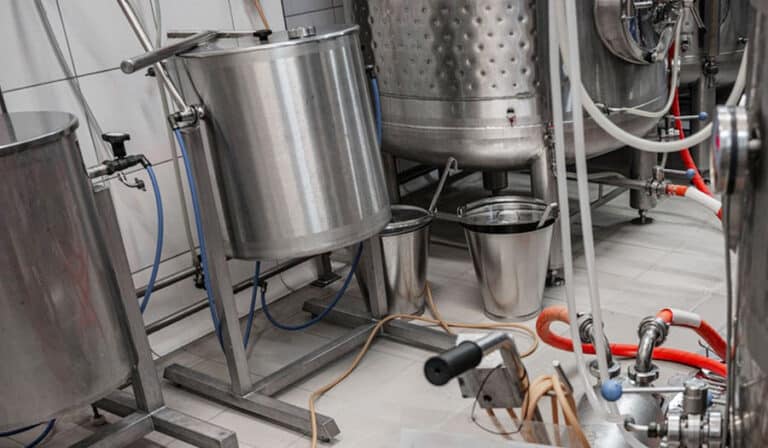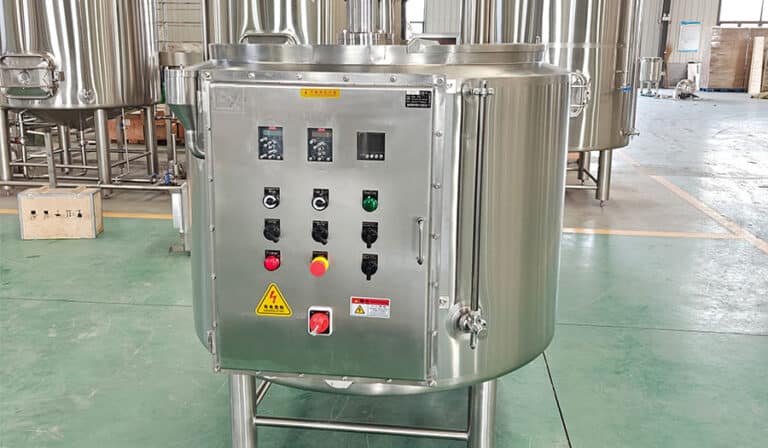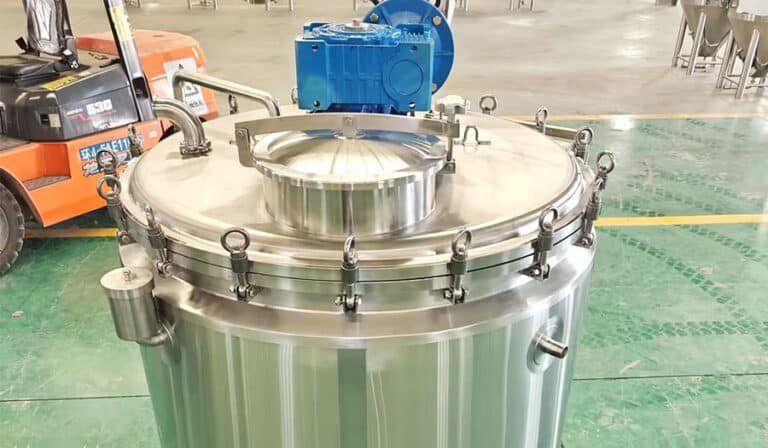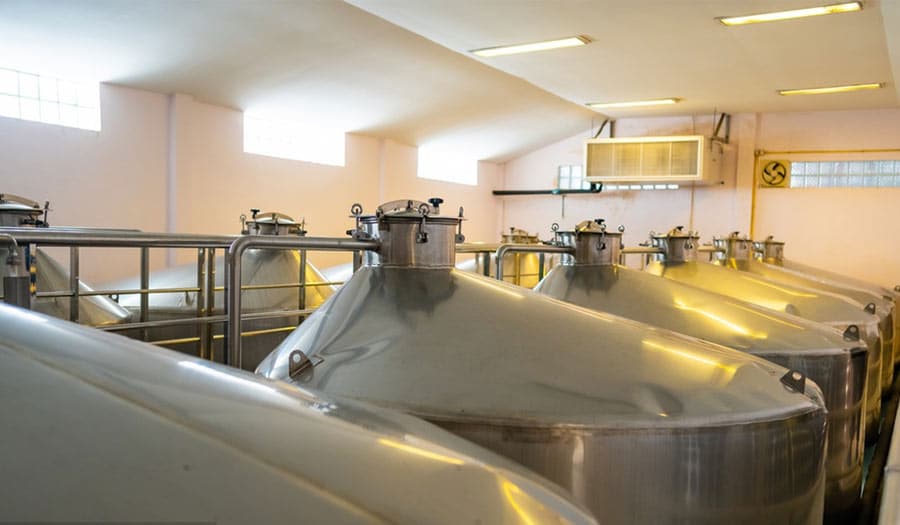In de moderne industriële productie zijn mengtanks een belangrijk type apparatuur en worden ze veel gebruikt in veel industrieën, vooral in de chemische, voedingsmiddelen-, farmaceutische, coating- en dagelijkse chemische industrie. De belangrijkste functie is het mengen van verschillende materialen in een bepaalde verhouding en op een bepaalde manier om productuniformiteit en stabiliteit te bereiken. Met de versnelling van het industrialisatieproces is de technologie van mengtanks zich blijven ontwikkelen. Van het aanvankelijke eenvoudige mechanische roeren tot de huidige geïntegreerde temperatuurregeling, drukregeling, automatisering en andere functies, is het een onmisbaar productiemiddel geworden in alle lagen van de bevolking.
A mengtank (een mixer of roertank) is een apparaat dat wordt gebruikt om twee of meer materialen te mengen, op te lossen, te dispergeren of te homogeniseren. Het bestaat meestal uit een container, een roerapparaat en een aandrijfmechanisme. Mengtanks worden veel gebruikt in veel industrieën zoals chemie, voeding, farmaceutica, dagelijkse chemicaliën, coatings en milieubescherming. Ze worden gebruikt om grondstoffen in verschillende vormen (vast, vloeibaar, gas) efficiënt te mengen in een bepaalde verhouding, op een bepaalde manier en met bepaalde vereisten om ervoor te zorgen dat het mengsel een uniforme samenstelling en stabiele eigenschappen heeft.

Het belang van mengtanks
- Consistentie behouden: Een van de belangrijkste redenen voor elke industrie om een mengtank te gebruiken is het garanderen van uniformiteit en kwaliteit van het eindproduct. In industrieën zoals de farmaceutische industrie, de voedingsmiddelen- en drankenindustrie en de chemische industrie is het nauwkeurig mengen van ingrediënten van cruciaal belang. Met behulp van een mengtank kunnen bedrijven een uniforme mix bereiken, waardoor een consistente kwaliteit en effectiviteit voor elke batch producten wordt gegarandeerd.
- Verhoogde productie-efficiëntie: Mengtanks verbeteren de productie-efficiëntie aanzienlijk door het mengproces te vereenvoudigen en te versnellen. In het verleden kon het mengen van grote hoeveelheden materialen met de hand of met behulp van rudimentaire apparatuur tijdrovend en arbeidsintensief zijn. Mengtanks met geavanceerde mengtechnologie kunnen grote hoeveelheden ingrediënten snel en efficiënt verwerken.
- Efficiënte integratie van componenten: Een andere belangrijke rol van mengtanks is het integreren van verschillende componenten in één samenhangend product. Dit is vooral belangrijk in industrieën waar het combineren van verschillende stoffen een uitdaging kan zijn. In de chemische industrie bijvoorbeeld vereisen sommige reacties precieze omstandigheden, zoals specifieke temperaturen of drukken, en mengtanks kunnen deze omstandigheden bieden.
- Flexibele productie: Mengtanks bieden een uitstekende flexibiliteit en zijn geschikt voor de productie van een breed scala aan producten. Deze flexibiliteit is vooral waardevol voor industrieën die zonder veel stilstandtijd moeten kunnen wisselen tussen verschillende formules of recepten. Oplossen en dispergeren: De mengtank kan onoplosbare stoffen effectief oplossen in de oplossing, of vaste deeltjes dispergeren in de vloeistof om een uniforme oplossing of suspensie te vormen. Emulgeren, dispergeren, oplossen en andere processen zijn bijvoorbeeld typische toepassingen van mengtanks. Bij de productie van emulsies, coatings, detergenten en andere producten zijn bijvoorbeeld mengtanks nodig.
- Temperatuur- en drukregeling: Veel productieprocessen vereisen reacties of menging onder specifieke temperatuur- en drukcondities. Mengtanks zijn meestal uitgerust met temperatuurregeling, drukregeling en verwarming/koeling om de stabiliteit van de reactieomgeving te handhaven en een nauwkeurige controle van het reactieproces te garanderen, waardoor de kwaliteit van het product verbetert.
- Bevorderen van de reactie of synthese van stoffen: In sommige chemische en farmaceutische productieprocessen spelen mengtanks niet alleen de rol van het mengen van materialen, maar bevorderen ze ook de reactie of synthese van grondstoffen door de omstandigheden zoals roeren, temperatuur en druk te regelen en zo de gewenste producten te genereren.
Voor welke industrieën worden mengtanks gebruikt? Chemische industrie
Chemische industrie
De chemische industrie is een van de industrieën waar mengtanks het meest worden gebruikt. Bij de productie van chemische producten worden meestal verschillende chemische grondstoffen gemengd, die vaak grote verschillen vertonen in fysische en chemische eigenschappen, zoals dichtheid, viscositeit, oplosbaarheid enzovoort.
- Chemische reactie mengen: Bij chemische reacties moeten verschillende reactanten vaak nauwkeurig in een bepaalde verhouding worden gemengd en onder de juiste omstandigheden reageren. Bij de productie van bijvoorbeeld kunstharsen, plastic additieven of meststoffen kunnen mengtanks stabiele mengcondities bieden om de volledige reactie van grondstoffen te garanderen en de kwaliteit en output van producten te verbeteren.
- Oplossen en dispergeren: Veel grondstoffen in de chemische industrie moeten worden opgelost of gedispergeerd in mengtanks. Bij de productie van coatings moeten pigmenten en harsen bijvoorbeeld gemengd worden met behulp van efficiënte roerapparatuur. Mengtanks kunnen de uniformiteit van de oplossing garanderen en gelaagdheid en neerslag voorkomen.
- Reactie bij hoge temperatuur en hoge druk: Bij sommige chemische reacties moeten de grondstoffen reageren bij hogere temperaturen of drukken, waardoor de mengtank bestand moet zijn tegen hoge temperaturen en hoge drukken en stabiel moet kunnen werken onder extreme omstandigheden.

Voedselindustrie
In de voedingsindustrie worden mengtanks ook veel gebruikt. Het verwerken van voedsel vereist meestal een nauwkeurige menging van grondstoffen om de smaak, voedingswaarde en stabiliteit van het product te garanderen.
- Mengen van vloeistoffen en poeders: Veel voedselproductieprocessen vereisen het mengen van vloeibare en poedervormige grondstoffen. Bij het bereiden van bijvoorbeeld dranken, sappen, zuivelproducten en specerijen kunnen mengtanks zorgen voor een gelijkmatige verdeling van verschillende ingrediënten en stratificatie of neerslag voorkomen.
- Productie van sauzen en specerijen: Bij de productie van specerijen zoals sojasaus, sauzen, ketchup enz. moeten mengtanks verschillende ingrediënten nauwkeurig proportioneren en mengen. Dergelijke mengtanks zijn meestal uitgerust met temperatuurregelsystemen om de stabiliteit en smaak van de specerijen te garanderen.
- Mengen van deeg en levensmiddelenadditieven: In het productieproces van voedingsmiddelen zoals brood en koekjes spelen mengtanks ook een belangrijke rol. De belangrijkste functie is het gelijkmatig mengen van grondstoffen zoals bloem, suiker, zout en olie om het deeg een betere textuur te geven en uiteindelijk de smaak en kwaliteit van het voedsel te verbeteren.
- Homogeniseren in voedselverwerking: Sommige hoogwaardige voedingsmiddelen, zoals zuivelproducten en ijs, moeten gehomogeniseerd worden om de smaak en de fijnheid van het product te garanderen. Mengtanks kunnen een goede uniformiteit bereiken en gelaagdheid van grondstoffen voorkomen door fijn te roeren en te controleren.
Farmaceutische industrie
De farmaceutische industrie stelt extreem hoge eisen aan mengtanks omdat ze rechtstreeks van invloed zijn op de werkzaamheid en veiligheid van medicijnen. In het farmaceutische proces moeten verschillende grondstoffen gemengd worden volgens strikte verhoudingseisen om de kwaliteitsconsistentie en stabiliteit van medicijnen te garanderen.
- Mengen van vaste geneesmiddelen: Veel medicijnen bestaan in de vorm van poeder of korrels. Tijdens het productieproces worden mengtanks gebruikt om verschillende grondstoffen gelijkmatig te mengen om de consistentie van actieve ingrediënten in elke dosis te garanderen. Dit is essentieel voor de productie van vaste geneesmiddelen zoals tabletten en capsules.
- Mengen en bereiden van vloeibare geneesmiddelen: Sommige medicijnen moeten in vloeibare vorm bestaan, zoals injecties, orale vloeistoffen, enz. In het productieproces van dergelijke producten spelen mengtanks een belangrijke rol. In het productieproces van dergelijke producten spelen mengtanks een belangrijke rol. Ze kunnen zorgen voor een uniforme menging van grondstoffen, voorkomen dat medicijnen neerslaan of stratificeren en zorgen voor een nauwkeurige concentratiecontrole.
- Bereiding van pasta's: De productie van geneesmiddelen zoals pleisters en crèmes is ook afhankelijk van de ondersteuning van mengtanks. Mengtanks kunnen niet alleen effectief roeren, maar ook de stabiliteit van de pasta garanderen en scheiding van componenten voorkomen.
- Kwaliteitscontrole van geneesmiddelen: De farmaceutische industrie stelt zeer strenge eisen aan de kwaliteit van producten. Mengtanks zijn meestal uitgerust met meerdere functies, zoals temperatuurregeling, drukregeling, snelheidsregeling, enz. om ervoor te zorgen dat het mengproces onder specifieke omstandigheden wordt voltooid, zodat aan strenge kwaliteitsnormen wordt voldaan.
Dagelijkse chemische industrie
Mengtanks in de dagelijkse chemische industrie worden ook veel gebruikt. Het productieproces van chemische producten voor dagelijks gebruik, zoals shampoo, douchegel, cosmetica, enz. vereist het nauwkeurig mengen van meerdere ingrediënten om de kwaliteit en het effect van de producten te garanderen.
- Emulgeren en dispergeren: Veel dagelijkse chemische producten, zoals lotions, crèmes, huidverzorgingsproducten, enz., bestaan meestal uit olie, water en emulgatoren. De mengtank kan deze ingrediënten gelijkmatig mengen tot een stabiele emulsie of pasta door middel van efficiënte emulgeer- en dispergeertechnologie.
- Mengen van aroma's en basismaterialen: Bij de productie van parfums en geurproducten zijn de mengvereisten van aroma's en basismaterialen erg hoog. De mengtank kan de verhouding tussen aroma's en basismaterialen effectief aanpassen om de stabiliteit van parfums en de persistentie van geur te garanderen.
- Bereiding van wasmiddelen: De productie van dagelijkse chemische producten zoals was- en reinigingsmiddelen is ook onlosmakelijk verbonden met mengtanks. De mengtank zorgt voor een gelijkmatige verdeling van verschillende oppervlakteactieve stoffen, oplosmiddelen en additieven, zodat het reinigingsmiddel een goede reinigende werking heeft.

Voordelen van mengtanks
- Efficiënt mengen: De mengtank kan verschillende stoffen snel en gelijkmatig mengen door middel van een efficiënt roerapparaat, waardoor de productie-efficiëntie aanzienlijk wordt verbeterd. Traditionele mengmethoden kunnen lang duren, maar moderne mengtanks kunnen door hun geavanceerde ontwerp efficiënt mengen in kortere tijd voltooien en productiekosten besparen.
- Nauwkeurige besturing: Moderne mengtanks zijn meestal uitgerust met geautomatiseerde regelsystemen die de mengsnelheid, temperatuur, druk en andere parameters in real-time kunnen controleren en aanpassen om ervoor te zorgen dat het mengproces voldoet aan vooraf bepaalde procesvereisten. Deze nauwkeurige regeling kan de consistentie en stabiliteit van het product sterk verbeteren en variaties en fouten in het productieproces verminderen.
- Aanpasbaar aan verschillende materialen: De mengtank kan verschillende materialen aan, zoals vloeistoffen, vaste stoffen, gassen en zelfs viskeuze materialen of materialen met een hoge viscositeit. Hij is zeer flexibel en er kunnen verschillende soorten mengtanks worden geselecteerd op basis van de productiebehoeften om met verschillende materialen en productieomstandigheden om te gaan.
- Energiebesparing en verbruiksvermindering: Energieverbruik en materiaalverlies kunnen worden verminderd door goed ontworpen mengtanks. Door bijvoorbeeld de mengmethode te optimaliseren en de warmte-uitwisselingsefficiëntie te verbeteren, kan energieverspilling worden teruggedrongen en kan de energiebenuttingsgraad van de productie worden verbeterd. Tegelijkertijd kan de mengtank ook de verspilling van grondstoffen verminderen, omdat de tank ervoor kan zorgen dat materialen volledig worden benut.
- Productkwaliteit verbeteren: Door het mengproces nauwkeurig te regelen, kan de mengtank de uniformiteit en stabiliteit van het eindproduct garanderen en zo de productkwaliteit verbeteren. In de voedingsmiddelen-, farmaceutische, cosmetische en andere industrieën kan uniform mengen niet alleen het uiterlijk, de smaak en de functie van het product verbeteren, maar ook de houdbaarheid van het product verlengen.
- Arbeids- en materiaalkosten verlagen: De meeste moderne mengtanks zijn uitgerust met geautomatiseerde besturingssystemen, die handmatige interventie, arbeidskosten en fouten in de productie sterk kunnen terugdringen. Tegelijkertijd kan het dankzij de efficiënte werkwijze de algehele efficiëntie van de productielijn verbeteren en materiaalkosten besparen.
- Hoge veiligheid: Veel mengtankontwerpen houden rekening met veiligheidskwesties tijdens het productieproces, zoals het mengen van hoge temperaturen, hoge druk of ontvlambare en explosieve materialen. Moderne mengtanks zijn meestal uitgerust met meerdere veiligheidsvoorzieningen, zoals automatische ontgrendeling als de druk te hoog is, automatische koeling als de temperatuur te hoog is, enz. om de veiligheid tijdens het productieproces te garanderen.
- Gemakkelijk te reinigen en te onderhouden: Moderne mengtanks zijn meestal gemaakt van gemakkelijk te reinigen, corrosiebestendige materialen zoals roestvrij staal en hebben een afneembare en wasbare structuur voor eenvoudige reiniging en onderhoud. Dit is vooral belangrijk voor industrieën met hoge hygiëne-eisen, zoals de voedingsmiddelen- en farmaceutische industrie, om kruisbesmetting van materialen te voorkomen en ervoor te zorgen dat producten voldoen aan de hygiënenormen.
Samenvatting
Als zeer efficiënte industriële apparatuur wordt de mengtank op grote schaal gebruikt in diverse industrieën, met name in de chemische, voedingsmiddelen-, farmaceutische, coating- en dagelijkse chemische industrie, waar het een vitale rol speelt. Het kan de uniforme menging, oplossing, dispersie, reactie en andere procesvereisten van verschillende materialen bereiken door nauwkeurig roeren, temperatuurregeling en drukregeling, waardoor de productie-efficiëntie wordt verbeterd, de productkwaliteit wordt gewaarborgd en de productiekosten worden verlaagd.




